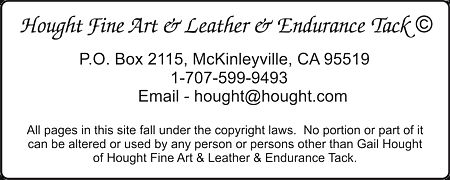|
|
|
||||||
|
5/31/02
Can you sense how it will feel? It all has to do with body mechanics of the horse. We have to sit still and perfectly balanced as usual. Now, we can slightly change our body position to stop, which the horse already knows, and lift either rein. When he begins to stop what do you expect to feel? He already understands your body language so when you lift the rein combined with your body language he will begin stopping with his front end loose and not braced up. The first tool we will be developing is lifting a shoulder with a single rein, slightly at first and gradually increasing. Once they have the lift clear, lift the shoulder, push with the same rein and counter arc them. Mechanically they have their spine out of alignment and don't have the strength of their whole body. This is really the beginning of the single rein stop. This will enable us to lift either shoulder at any time. Now, put it together. What do we have? They keep moving in front and don't brace up. Begin preparing the horse while riding on the trail. It is more difficult in an arena situation because it is just drill, you and the horse get bored, not to mention that you can become demanding. Out on the trail there is no pressure and you can do it 25 times during a 2 hour trail ride and not cause a problem. If a problem is developing, slow down with the frequency of times you ask and require less movement of the face and/or shoulder. It starts with just a little lift in the face and slowly grows in range of movement with non pressured repetition. By the end of the first ride don't expect them to have it learned, because you have just introduced the concept of the single rein and they may have begun to show some understanding and movement. Remember that they are a creature of habit. Just develop the good habits. Good habits take time to develop so expect to spend 4-5 rides of an hour or two per ride. Now, once they are beginning to execute the skill correctly it does not mean it is completed. It is perfectly natural to spend the rest of the horse's life refining, reviewing and perfecting. This skill is key to preparing and correcting many skills. It has so many uses that you will be using and modifying it to improve body mechanics and correct poor habits. Remember right rein, right foot? It softens
the front end, neck and face because we are only asking for one
side. Yes, it really works. Here's what to look for. You will
begin to feel the rear end stopping and the front end still moving.
He may want to turn slightly to the side you are asking, but
at first that will happen. Slowly, you will be able to ask less
with the rein because he understands that you are not asking
for the turn just the stop. Remember body language and consistency
from you is a must. It will take a few times but it will come
together pretty soon. Be consistent with your ask, body language
and wait. So if the front end is moving he can't brace up to
stop on his front end. |
||||||
|
